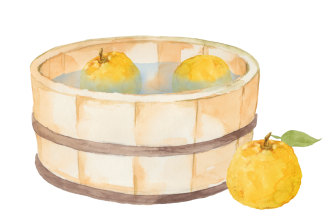The secret to a better bath? Look to your garden bed
By Robin Powell
I once shared a hot spring bath in Japan with half a dozen fresh yuzu. I pierced the skin of the fruit with my fingernail to release its wonderful, distinctive, fresh fragrance. That yuzu bath is my top Japanese Bath Experience of all time – so far. More than that it was doing me good: a yuzu bath taken at around the time of the winter solstice was believed in the Edo period to increase circulation and prevent colds.
As the winter solstice nears, I’ve been dreaming of a yuzu bath and its many charms and protections. But I don’t grow yuzu and don’t think a squirt of bottled yuzu juice in my enamel tub will suffice, so I’m going to have to experiment with another citrus.

A yuzu bath taken at around the time of the winter solstice was believed in the Edo period to increase circulation and prevent colds.Credit:iStock
Yuzu is just one of the world’s many citrus, all of which are derived from a dozen or so species that emerged in Asia, Melanesia and Australia about 10 million years ago. Yuzu has a reputation for being difficult to grow, largely because of its long and lethal thorns, which damage not just the unwary gardener, but also the fruit. It’s also slow: if grown from seed it can take 20 years to bear fruit.
An easier Japanese citrus is sudachi, which grows to 4-5 metres in good garden conditions. Sudachi and yuzu are both available as grafted trees in Australia but neither are grafted onto dwarf rootstock, so best suit gardens with plenty of sunny space.
Grafting citrus onto a dwarf rootstock called “flying dragon” slows the growth of the tree and reduces its ultimate height to about half of the original, making perfect options for both small gardens and potted gardens.
Sydney citrus specialist Engalls Nursery offers 16 different dwarf citrus, from lemons and limes to oranges, grapefruit, mandarins and calamondin.
Not familiar with the calamondin, Citrofortunella microcarpa? Fair enough; it is often confused with cumquat, Fortunella margarita ‘Nagami’. But where Nagami cumquats are oval with bitter flesh and sweet skins, ideal for marmalade; Calamondin are rounder and bigger. They are known as calamansi in the Philippines where the hot weather means they never turn orange, remaining green even when ripe, and providing the juice for a delicious cordial. Pretty good in a bathtub, I would think.
Whether growing in a pot or in the garden, choose a spot for citrus that gets about six hours of sunshine a day. For pot culture, choose a big pot, around half wine barrel size, and you won’t have to worry about repotting. I’ve had dwarf lemons and kaffir lime in the same pots for 30 years. And it’s a kaffir lime that’s going to join me in my next bath.
Make the most of your health, relationships, fitness and nutrition with our Live Well newsletter. Get it in your inbox every Monday.